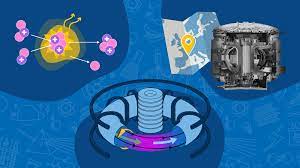Nuclear Fusion : Study

Scientists have managed to repeatedly produce nuclear fusion ignition for the first time, marking a major milestone towards achieving near-limitless clean energy at scale.
- Nuclear Fusion is the process by which two light atomic nuclei combine to form a single heavier one while releasing massive amounts of energy.
- Fusion reactions take place in a state of matter called plasma—a hot, charged gas made of positive ions and free-moving electrons with unique properties distinct from solids, liquids, or gases.
- The sun, along with all other stars, is powered by this reaction.
- Tokamaks devices designated for the task of doing this here on Earth—nuclear fusion reactors — are called tokamaks.
- Tokamaks are often also called ‘artificial suns’ due to the fact that these doughnut-shaped machines replicate processes that occur in the sun.\There are currently over 200 tokamaks in operation across the globe, with the scientific milestones achieved in these devices developing a roadmap for the operation of the International Thermonuclear Experimental Reactor, or ITER, the world’s largest fusion experiment under construction in the south of France.
- A commercial tokamak will aim to use the thermal energy of plasma heated by fusion to heat water, create steam, and, in turn, spin a turbine that generates electricity.
- Though fusion can involve a wealth of chemical elements, the nuclear reaction that most tokamaks aim to make viable is the fusion of the heavy hydrogen isotopes deuterium (with a nucleus of one proton and one neutron) and tritium (one proton and two neutrons).
- Fusing the atoms of these elements together creates a neutron and a helium nucleus.




